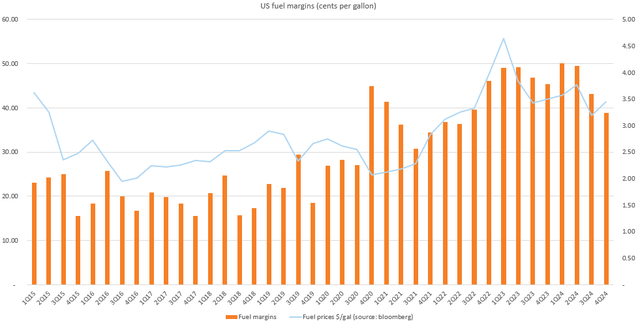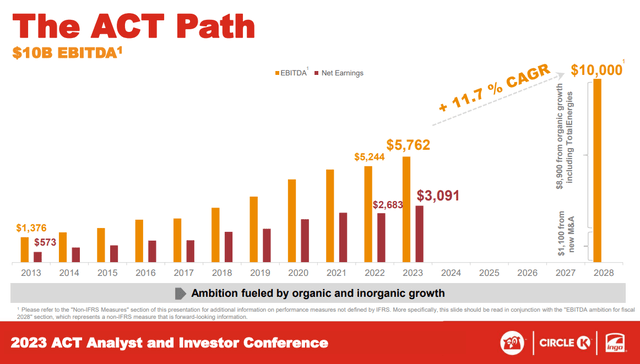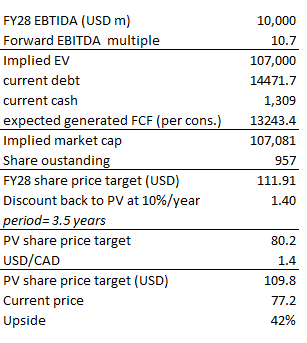Investment action
I recommended a hold rating for Alimentation Couche-Tard (TSX:ATD:CA) [ATD] when I wrote about it in April, as I wanted to wait for a better entry point given the uncertain macro environment. Based on my current outlook and analysis, I again recommend a hold rating. ATD’s 4Q24 results have certainly shown positive developments; however, I believe the stock is unlikely to move up given the visible pressure on fuel margins and pressure on discretionary spending (which impacts merchandise growth). Nonetheless, ATD deserves to be on the watchlist as the potential upside is huge if management can deliver on its FY28 EBITDA targets. Execution so far has been great, so the main problem is when will the macro environment turn better.
Review
ATD reported earnings two days ago, which saw total revenue of $17.6 billion, gross profit of $2.78 billion (~16% gross margin), EBIT of $642 million (3.7% margin), net income of $461 million, and adj EPS of $0.48. On an adj EBITDA basis, ATD reported $1.143 billion, which missed the consensus estimate of $1.191 billion. The same was for adj EPS, where ATD missed consensus estimates modestly by 2 cents. Splitting the performance by region, in the US, ATD reported merchandise same-store-sales [SSS] growth decline of 0.5% y/y, SSS fuel volumes decline of 1.6% y/y, and fuel retail prices down 3.4% y/y to $3.40 (US fuel margin came in at 38.79 c/gallon). Outside the US, ATD reported a merchandise SSS decline in Europe & Other Regions of 2%, while SSS in Canada fell 3.4%. Excluding the impact of the integration of certain retail assets from the TotalEnergies acquisition, ATD’s merchandise margins in Europe & Other regions would have been flattish. As for Canada, merchandise margins were up 80bps to 34.9%. Regarding the fuel segment, SSS fuel gallons in Europe & Other Regions were down 1.7% and were down 3.5% in Canada. Fuel margin wise, Europe & Other Regions saw 8.30 c/liter and CAD 13.68 c/liter in Canada. At a high level, I believe ATD reported weak 4Q24 results that reinforced my view that the current macro situation continues to weigh on performance. However, I think there are bits and pieces of positives hidden in the results that are encouraging.

Author’s work
I will start off with the negatives. Firstly, US fuel margins have continued to trend sequentially lower in 4Q24, and given the poor outlook for fuel prices, it is likely that fuel margins will continue to be pressured in the coming quarters. Given that this is 30% of total gross profit, the impact on earnings will be prominent. Secondly, challenging macro conditions continue to pressure discretionary spending, particularly for low-income consumers, as was pretty evident from the SSS growth performance across all regions. Thirdly, the impact of the increase in tobacco taxes in Hong Kong has exceeded my expectations. Given that taxes are unlikely to unwind, demand losses may be permanent. As such, there are visible headwinds to ATD business that we can reasonably believe may continue in the near term.
That said, not all is lost. There are also multiple positive takeaways. Firstly, if we just look at adj EPS performance, although it was down another 32% y/y (once again missing consensus expectations), it is important to note that 4Q24 had 1 less operating week vs. 4Q23. This makes the y/y comparison not like-for-like. If we exclude this impact, adj. EPS growth would have been down in the low-20s percentage as per management estimates. If we use 21% as an estimate, this implies an adj. EPS figure of ~$0.52, which beats consensus estimates.
Secondly, although merchandise SSS performance is not great, there are early signs of positive recovery in the US (SSS growth has improved sequentially from -1.5% y/y in 3Q24 to -0.5% y/y in 4Q24). This is a very positive improvement and I see potential for ATD to accelerate its merchandise SSS growth from the revenue synergies with TotalEnergies. Note that TotalEnergies’ inside store sales focus less on food and merchandise, and this gels well with ATD, which has expertise in food service and already has a large European footprint. ATD should be able to extract both revenue (selling into TotalEnergies’ footprint) and cost (operating costs split over a wider store base) synergies.
Thirdly, the 4Q24 performance really highlights the strength of the ATD partnership relationship with its tobacco partners and why I think these partners will continue to rely on ATD. In the call, management noted that Altria and BAT’s saw high single-digit unit loss rates, but ATD outperformed them. Which means these partners are selling better at ATD than their own channels. A major contributing factor, I believe, was ATD investment in digital capabilities, a differentiating factor that allows ATD to capture share from independent site operators. Additionally, ATD investment in alternative nicotine products has also started to contribute as it reported positive growth in 4Q24. This should improve ATD’s tobacco sales outlook, as it helps steer ATD away from the structural decline in cigarette volume.
We now just with Altria in the United States have over 1.2 million digital transactions weekly with them. So we’re providing value that really only some of the chains can that they’ve got digital capabilities, including loyalty platform. 4Q24 call
Next, ATD’s cost optimization efforts continue to show up in the P&L. ATD was able to reduce its normalized operating expenses by 1.1% compared to last year as a result of various cost-cutting measures, including the expansion of its centralized back office operations. When put in context with inflationary pressures, the effects of increasing minimum wages, and incremental investments to bolster strategic initiatives, this is quite remarkable. So far, ATD has already recognized nearly half of their $800 million cost savings initiative that was expected to be recognized by FY28, as laid out at their recent investor day. As such, I believe there is upside to this cost-saving guidance.
So, yeah, we feel pretty good about the program that we introduced last year. We were mentioning the $800 million addition for the five years. I tell you that today, we have almost reached half of the journey already. 4Q24 call
The final point to touch on is the change in CEO. ATD announced that Alex Miller, Chief Operating Officer, will become CEO effective September 6, 2024. The current CEO (Mr. Brian Hannasch) will retire and continue as a special advisor to the new president, CEO, and Executive Chairman of the Board. I wouldn’t be too worried about this change, as Alex is no outsider. Since his 2012 arrival at ATD, when he was named Director of Fuels, Real Estate, and Facilities, he has steadily advanced through the ranks. It is important to note that ATD has been actively pursuing this transition for the past five years, so Alex should already be well-equipped by this point. My overall impression is that this transition will be smooth thanks to Mr. Miller’s extensive experience and Mr. Hannasch’s intention to continue serving as Special Advisor to ATD for the next two years.
All in all, while there are positives, given the pressures on the lower-end consumer that are likely to persist in the near term given the challenging macro environment, I believe the next few quarters are going to remain soft. Until there is a sign that fuel margins are improving, or the macro environment improves, I do expect the stock to stay range bound.
Valuation

ATD
So, the upside case for ATD boils down to two things: macro-recovery and execution on growth initiatives (synergies with TotalEnergies, growing nicotine alternative products, growing loyalty programs, growing food services, etc.). I was just wondering what ATD could be worth if I took a step back and assumed all of these things played out (would it be worth my time to continue monitoring ATD?). The answer is yes. Assuming that ATD can achieve its FY28 EBITDA target, and it trades at its historical forward EBITDA multiple of ~10.7x (historically trades within a tight range of 9.8x to 11.4x), my model suggests ATD is worth CAD110 at present value (42% upside).

Author’s work
Risk
Fuel margins could go a lot lower than the pre-COVID lows if the Middle East ramps up supply by much more than expected. Although the new CEO has a decent background, if the transition is not done properly, it could impact ATD’s ability to execute its growth strategies in the near term. Discretionary spending could stay pressured for longer than expected if inflation continues to stay sticky, prompting the Fed to raise rates.
Final thoughts
My recommendation is still a hold for ATD despite 4Q24 showing some positive developments like strong cost control and early signs of merchandise SSS recovery. My concerns are the near-term headwinds from pressured fuel margins and weak discretionary spending. That said, if the macro recovers and ATD delivers on its EBITDA target, the potential upside is significant. However, considering the current challenges, a hold rating is recommended until there are signs of improvement.
Editor’s Note: This article discusses one or more securities that do not trade on a major U.S. exchange. Please be aware of the risks associated with these stocks.
Read the full article here


